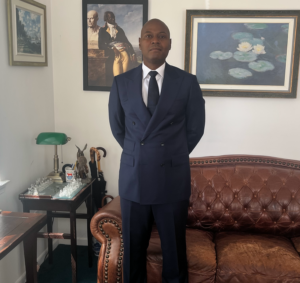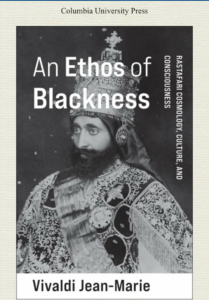Welcome to 7 Questions, our series where we highlight exciting scholars in the field of religion and get to know the person behind the book. For this article, we interviewed Vivaldi Jean-Marie, whose book An Ethos of Blackness: Rastafari Cosmology, Culture, and Consciousness was published with Columbia University Press this September. You can read our excerpt of the book here.
Get to Know Vivaldi
 Vivaldi Jean-Marie teaches in the African American and African Diaspora Studies Department at Columbia University and is a professor of philosophy at the City University of New York. He is the author of Vodou Cosmology and the Haitian Revolution in the Enlightenment Ideals of Kant and Hegel (2018), Reflections on Jean Améry: Torture, Resentment, and Homelessness as the Mind’s Limits (2018), Kierkegaard: History and Eternal Happiness (2008), and Fanon: Collective Ethics and Humanism (2007).
Vivaldi Jean-Marie teaches in the African American and African Diaspora Studies Department at Columbia University and is a professor of philosophy at the City University of New York. He is the author of Vodou Cosmology and the Haitian Revolution in the Enlightenment Ideals of Kant and Hegel (2018), Reflections on Jean Améry: Torture, Resentment, and Homelessness as the Mind’s Limits (2018), Kierkegaard: History and Eternal Happiness (2008), and Fanon: Collective Ethics and Humanism (2007).
Vivaldi Answers Our 7 Questions
Question 1: What sparked the idea to write this book?
An Ethos of Blackness was inspired by my ruminations about how Rastafari movement illustrates one of the axioms of political philosophy, specifically that a nation state and a people are concomitant to the elaboration of a system of socio-cultural norms, values, and religious beliefs. This axiom was the unifying thread in my textual reading and empirical observations of the rituals, social and communal practices of Rastafari. I slowly derived the conclusion that Rastafari is striving to elaborate an alternative system of socio-cultural norms, values, and religious beliefs to those that people of African descent in the Diaspora inherited from slavery and colonialism. An Ethos of Blackness articulates this alternative system by means of which Rastafari delineates an Afrocentric conception of people of African descent.
Question 2: What role does the sacred play in relation to your work broadly? Where do you see the sacred or sacred things in this book specifically?
A Black theological concept of the sacred is a primordial aspect of An Ethos of Blackness. In the book, it is prominent in Rastafari Black theology and hermeneutic. Rastafari’s conception is illustrated in the messianic model inherent in Rastas’ reception and interpretation of biblical scriptures. The Rastafari’s conception of the sacred draws continuity between religiosity and the social amelioration of the circumstances of people of African descent. The conception of the sacred unfolds through Rastas’ messianic model. The messianic model encapsulates Rastas’ attitudes toward their present and future which they view as temporal media for the redemption of the Black Messiah.
Question 3: If you were to describe the book to someone who is unfamiliar with religious and academic jargon, how would you summarize it?
The goal of the book is to show that Rastafari’s religious, cultural, and aesthetic conventions are strategies that Rastas use to invent an alternative view of Blacknes. Rastas’ alternative view of Blackness is invented around Afrocentricity and in resistance to the Eurocentric and colonial conception of Blackness.
Question 4: Who were models or inspirations for you as you wrote this book?
I derived inspirations to write An Ethos of Blackness from teaching and my reflections on the central claim of political philosophers, namely, the distinctiveness of a people’s national identity is grounded in their religious, cultural, political and social norms. Michel Foucault’s undertaking of an archaeology of knowledge throughout his corpus inspired me, as well.
Question 5: What was the most difficult thing about writing the book? Did you encounter any unexpected problems or challenges?
The key difficulty was to articulate the complex and rich practices of Rastafari in clear and accessible language for readers who are not familiar with Rastafari. The second one was to show that these complex and rich practices have a cohesive aim specifically: the creation of a distinctive conception of Blackness.

Question 6: What has surprised you the most about the book, either in its writing or reception?
I was surprised to find in my research for the book that Martin Luther created a pictorial illustration of God, Adam, and Eve as Europeans to accompany his 1534 Bible (also known as Weimar Bible of 1534). I reached the conclusion that Martin Luther played a key role in framing Christian theology in Eurocentrism by depicting the biblical figures as white Europeans. In addition, it undermined God as a sheer spiritual entity and broadcast the popular imaginaries of God as a white patriarch and established the original humans as white people. This fact was, further, promoted by the paintings of the Renaissance. Finally, an important ambition of Rastafari is to supply an alternative to Martin Luther’s Eurocentric framing and undermining of God as a spiritual entity for people of African descent. Rastas adopted the European emperor Haile Selassie as their Godhead and argued that the original humans were Ethiopians.
Question 7: With this book done, what’s up next for you?
I want to devote a monograph to the practice of surveillance in western societies and the form of socio-institutional knowledge that surveillance generates. In essence, the aim is to show that this dominant form of socio-institutional knowledge differs significantly from the epistemological take on knowledge as justified true beliefs.
You can order An Ethos of Blackness: Rastafari Cosmology, Culture, and Consciousness here.
